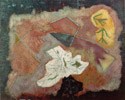
of Plants, 1945

|
|
Movement of Plants, 1945 |
The enrollment of the young Stamos into the avant garde movement right from the beginning in the middle of the Forties constituted a recognition of his work, first of all by his colleagues themselves. Nevertheless, this had been preceded by his meeting with Betty Parsons in 1943, which was definitive for the formation and reception of his work; she was then the director of the Wakefield bookstore and gallery, a meeting place for the surrealists in exile. This perspicacious art dealer was enchanted by the fresh "naivete" of the early anti-naturalistic works of this painter just turned twenty-one and organized his first one-man show. During a period when criteria for the new had yet to be fashioned, Parsons found in the young Stamos, as well as in other artists among whom were Hedda Stern, Joseph Cornell and Adolph Gottlieb, non-conformist painting with a personal and instinctive character[13]. Her choice in this matter did not disappoint her, if we judge by their long-term collaboration and the enthusiasm with which she supported his work. At the end of 1944, Stamos, along with the rest of the members of the Wakefield, followed Betty Parsons to the Mortimer Brand Gallery and in 1946 to her own gallery bearing her name. As is characteristically mentioned by the biographer of Betty Parsons, Lee Hall, it was not the eccentric appearance of the young, defiant artist that impressed the pioneering gallery owner. The main thing that she recognized in Stamos and for which she established him as one of the leading members of her gallery, was the "sense of natural forces" the artist possessed "and his ability to translate this perception into painterly expression"[14].
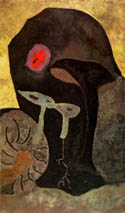
|
|
Sounds in the Rock, 1946 |
The importance of this co-operative endeavour for the early promotion of the work of Stamos or, more correctly, for the fashioning of the preconditions for its reception, can be understood if one only considers that around 1947, after the closing of Peggy Guggenheim's gallery "The Art of Century", the Betty Parsons Gallery gathered together most of the innovative painters from among whom would later emerge the greatest names of the Abstract Expressionist movement, such as Rothko, Newman, Pollock, and Still. It is indicative of the attraction exercized by this new exhibition space that many museums kept their eye on the selections of the owner which were considered to be a "barometer" for the American avant garde[15]. It is worth noting that the fashioning of the gallery's space, according to the point of view stated by Parsons herself, did not offer spectators any comforts but obliged them to look at the new paintings standing, in the way of an intellectual exercise[16].
We should also say that this artistic environment was in absolute correspondence to artistic production which placed an emphasis on the study of nature, the genesis of myth and the expression of one's inmost feelings. It goes without saying that there were sales. The young Stamos had more than a small share of them during this period, at least until 1950[17]. It is not by chance that eminent foundations, such as, among others, the Museum of Modern Art, the Whitney Museum of American Art, the Metropolitan Museum of Art and the Walker Art Center purchased his works, a fact that Betty Parsons did not neglect promoting through the press, as occurred with the acquisition of the work "Sounds in the Rock" in 1947 by the Museum of Modern Art of New York[18]. This fact that foundations with enormous institutional power were involved aroused even more the interest of collectors, who had already begun to buy works by the young painter. Characteristic of this is the case of Edward Root who, moved by the same love as Stamos "for nature and art" according to the title of an essay by Mary Murray which is published in the current volume, bought a large number of works during the decade 1945-1955. Another large collector, Duncan Phillips, must also be mentioned. This famous collector of the works of French Impressionism, who it is worth noting had especially esteemed the pastels of Stamos, not only started buying works of his in 1949 but also organized two exhibitions for him at his own private gallery in Washington D.C. (1950,1954).

|
| The Three Furies, 1946 |
If the above-mentioned events sketch out the objective framework of the handling of the early work of Stamos, the exhibition entitled The Ideographic Picture which Barnett Newman organized at the Betty Parsons Gallery in January 1947, in which the artist participated, decisively opened for all the colleagues of the gallery a horizon of reception, the basic points of which were primitivism and modern American painting. The linking up of these two points was emphatically undertaken by Newman in the prologue to this brief but highly significant brochure. In this text the theoretician and painter notes[19], among other things, that already during World War II a new force in American painting emerged spontaneously and from many places at the same time which echoed in a modern way the passion of primitive art.
Particularly worthy of note is Newman's observation that while already by 1942 critics and art dealers were endeavouring to find a name and to describe this phenomenon, it was then the time for the artists to take matters into their own hands and to show through their works and their theoretical utterances the community of interest behind their intentions. Furthermore, throughout Newman's formulation[20], as he endeavoured to give a single identity to the group, there is revealed if not an irresolute at least an ambiguous position in regard to the characterization "abstract" painters. On the one hand he recognizes that the participating painters are working in a so-called abstract style but on the other he rejects that label. It is obvious that despite their unquestioned leaning toward the abstract, they were also bringing back the concepts of theme and content in the guise of the subjective idea. Nevertheless, the young Stamos did not possess similar theoretical equipment and by temperament was bored with the discussions that were organized by the group of artists and in which, moreover, he seldom participated[21]; aided by a form of reflection which was more of the hand and the act than of words and the intellect, he had a profound understanding of the pulse of these artistic quests and set them down in poetic works, some of the most mature paintings of the group. The importance and value of these works was recognized by Newman himself, who one month after the show The Ideographic Pirture, wrote the prologue to the small catalogue of the most important one-man exhibition by Stamos before 1950, which took place at the Betty Parsons Gallery. It would be an omission on our part if we did not quote immediately below this text, which is of great importance, despite its aphoristical character[22]:
Communion with nature, so strongly advocated by the theorist as the touchstone of art, the primal aesthetic root, has almost always been confused with a love of nature. And the artist falling in love with the trees and the sea, the beast and the bird, has not so much been in love with them as with his own feelings about them. That is why the historic attitude of the artist towards nature has been, in non-primitive peoples, one of sensibility. The concept of communion became a reaction to rather than a participation with, so that a concern with nature, instead of doing what it was supposed to do give man some insight into himself as an object in nature-accomplished the opposite and excluded man; setting him apart to make nature the object of romantic contemplation.
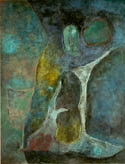
|
| What the Wind Does, 1947-49 |
The work of Theodoros Stamos, subtle and sensuous as it is, reveals an attitude towards nature that is closer to true communion. His ideographs capture the moment of totemic affinity with the rock and the mushroom, the crayfish and the seaweed. He re-defines the pastoral experience as one of participation with the inner life of the natural phenomenon. One might say that instead of going to the rock he comes out of it. In this Stamos is on the same fundamental ground as the primitive artist who never portrayed the phenomenon as an object of romance and sentiment, but always as an expression of the original noumeristic mystery in which rock and man are equal.
Stamos is able, therefore, to catch not only the glow of an object in all its splendour but its inner- life with all its dramatic implications of terror and mystery. In doing so he makes clear- the important difference between the sense of nature and the act of worship.
In regard to its overall conception this prologue combines general observations about the authentic relationship between the primitive/artist and nature with specific value judgements of the 17 biomorphic works by Stamos which were being presented in the exhibition. As a critical act of the deepest importance, this brief text sets down the basic parameter-s of the movement under formation and at the same time gives its blessing to one of the members of the group. The aesthetic characterization of these works as "subtle and sensuous" is the least important one. What is important is that Newman discerns and recognizes in his young colleague the reestablishment of the total, mysterious and devotional relationship of the artist to nature. It must not go unobserved that the most theoretical of these modernist artists avoided any mention in his text, or even any allusion to the formalistic part of Stamos' paintings or to his tendency toward the abstract. On the contrary, he puts emphasis on the thematic idea contained therein, an idea from which emanates a broad spectrum of the most profound emotions, all the way to "terror" and "mystery" and the dramatic communion between nature and artist. Guided by this spirit he characterizes these biomorphic works as "ideographs". In Newman's adherence to ideographic symbol-making, the return to the subject and the emotional charge given to the painting, one recognizes the most durable core of the group's connective tissue. And it is precisely this core that was incompatible with formalistic approaches or at the very least did not favour them.
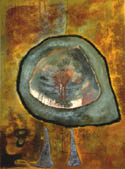
|
| Echo, 1948 |
Nevertheless, in coming to grips with Stamos' work, together with the by and large anecdotal references and the descriptions of colours[23], formal observations are also included as can be seen from the critical reviews. Thus, Thomas Hess in his related article[24] not only observes that Stamos' natural visions are subject to distortions for purely painterly reasons, but excludes in the title the abstract process the artist employs on the physical object of reference. Furthermore, the critic Judith Reed in a review[25] of the exhibition of 1947, and in reference to Newman's prologue, expresses reservations about the intellectual and theoretical formulations and the language of ostracism and proceeds to the timely observation that the poetry of Stamos' works is due to "abstract interpretations of natural objects" through the compositions that create impressions of fear, sacrifice and so on.
With the identity provided by his participation at the Betty Parsons Gallery and the merit attached by Newman's positive criticism, the young artist intensified his activity, something that had already manifested itself by at least 1945, when for the first time he participated in the annual painting exhibition at the Whitney. After three years of appearing in the same exhibition he was granted an honorary space in the first room, where his painting titled Altar was also on display. But while until then the reviews had discerned an abstract character in Stamos' works, the great Clement Greenberg, harshly criticizing[26] the abstract trend, as it appeared in the annual exhibition of 1948, mentions the exhibited work of Stamos as an example. Considering the whole trend to be easy to digest, pseudo-advanced and only for that reason attractive to the public as a separate kind of painting, he inveighed against Stamos' work, which he characterizes as "sweet, inept and utterly empty", adding that he drew on stylistic elements from the lower aspects of Baziotes, whom Greenberg judges to be a more serious and superior artist. From this article by the famed theoretician and art critic, which we will have serious reasons to examine again at the end of this introduction, we will content ourselves, for the present, with his observation, despite the fact that it indicates disfavour, that in 1948 Theodoros Stamos had occupied a prominent position in the newly-born abstract movement. And this was not unwarranted as is shown by a series of documents.
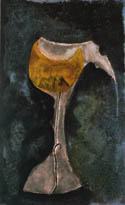
|
| Moon Chalice, 1949 |
For example, in October 1948 Life, a mass circulation magazine, organized an event at MOMA to familiarize the public with the "strange" extremist and peculiar works of the "modernist" tendency. During this event 15 distinguished specialists were called upon to evaluate and comment on such works and preferably those in the collections of the famous museum. Six of them chose the work of Stamos, which we mentioned earlier, Sounds in the Rock. Of these opinions, some of which were unfavourable or guarded, the best documented appear to be those of Soby and Sweeney[27]. The latter deemed the painter pleasing, and praised his personal and sensitive vision but remained guarded in regard to his broader vision. Soby considered the specific work as representative of the contemporary trend in American painting, whose main characteristic was, in his opinion, the return to nature and the shift of interest from the mechanical to the natural subject. It is interesting that Soby, who it is worth noting was the director of the Department of Painting and Sculpture at the Museum of Modern Art, characterized that the same year, in his book, "Contemporary Painters"[28], the work under discussion as "distinguished", and placed the artist in the current of organic abstraction. Referring to the kinship that he detects with the older painter (also of Greek origin), William Baziotes, he stresses that "Stamos is already quite clearly a painter of exceptional talent and depth".
The fame of the artist was continually growing and the fact that he was again promoted by a magazine that was aimed at the broader public was not without importance. In 1950, Life, setting in motion a complex mechanism of selection, decided to show and to promote from among 450 artists in 38 States, that were no more than 36 years old, the 19 most outstanding[29]. In this strictly limited and quite prestigious number was included the then twenty-four year old Theodoros Stamos. The works of those chosen were exhibited the same year at the Metropolitan Museum of New York. Approximately two months later the letter of protest which we spoke of at the beginning of our introduction would be written.
With his inclusion in the photograph of 1951 and his participation the same year in the exhibition that Robert Motherwell organized under the title Seventeen American Modern Painters at the Frank Perls Gallery in California, the first phase of the artistic career and reception of Theodoros Stamos came to a close.
Looking ahead we should perhaps mention right now that the works of this period and their acceptance by his fellow artists and institutional figures, determined the way Stamos would be dealt with later on by critics and historians. This is also valid for all those who defended the artist's mature and late work, Barbara Cavaliere for example, and for all those who have turned their backs on something, in part or in whole, as has occurred with recent histories and retrospective exhibitions of the movement.
|
© ART TOPOS 1996, 1998 |
With the kind support of |